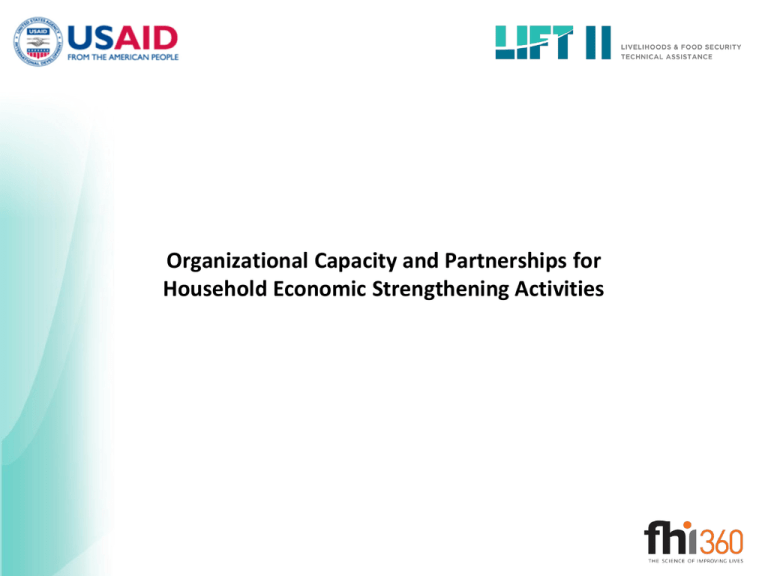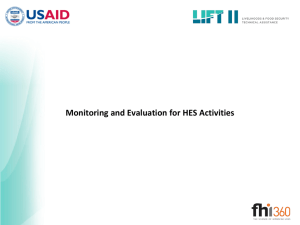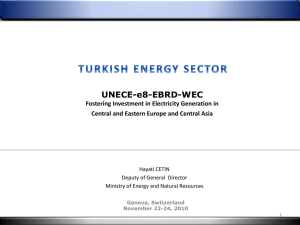Organizational Capacity and Partnerships for Household Economic
advertisement

Organizational Capacity and Partnerships for Household Economic Strengthening Activities Course Objectives By the end of the training, you will be able to… Explain why HES activities will enhance existing programs for VC Explain how HES activities fit into their organizational mission and goals List the general steps necessary for planning and implementing HES activities Identify core organizational strengths and weaknesses for implementing HES activities Name four key components of partnerships Identify key challenges of forming partnerships and corresponding strategies for mitigating them Develop a plan for working with colleagues to do a deeper assessment of organizational capacity What is Household Economic Strengthening? “A portfolio of interventions to reduce the economic vulnerability of households and empower them to provide for the essential needs of the children they care for, rather than relying on external assistance.” PEPFAR working definition, 2011 Why HES Activities? Why HES Activities? Benefits to target audience Benefits over other types of interventions Benefits to organization (mission fit, strategic objectives, etc.) ??????? Health Kits ??????? Organizational Capacity Organizational Capacity Overall OC OC to implement HES Activities What do you do? What are you planning to do? How well do you do it? How strong are your ‘systems’? How well can you do it with your current resources? What is your capacity to enhance existing resources in order to do it well? Overall Organizational Capacity Resources for Assessing Organizational Strength Technical and Organizational Capacity Assessment Tool (TOCAT) Organizational Capacity Assessment (OCA) Strengths, Weaknesses, Opportunities and Threats Analysis (SWOT) MCAT – Management Capacity Assessment Tool Finance, administrative, grants management MOST – Management Organizational Strengths Assessment Tool NHOCAT – National Harmonized Organizational Capacity Assessment Tool Technical and Organizational Capacity Assessment Tool (TOCAT) Core Functional Areas Principal Capacity Domains 1. Number, Mix and Capacity Of Technical Staff 2. Technical Quality Standards 3. Technical Supervision A: Institutional & 4. Training and Mentoring Programmatic Technical 5. Client/Beneficiary Communications Capacity 6. Community Involvement 7. Service Delivery Organization and Quality Assurance 8. Referral Systems for Continuum of Prevention, Care and Support Services 1. Governance and Leadership 2. Management Practices B: Institutional & 3. Operational Planning Programmatic 4. Structure: Roles and Responsibility Organizational Capacity 5. Structure: Delegation of Authority and Decision-Making 6. Staffing and Human Resource Management 7. Partnering and Networking Technical and Organizational Capacity Assessment Tool (TOCAT) Core Functional Areas C: Financial Management Systems Principal Capacity Domains 1. Financial Planning and Budgeting 2. Cash and Banking 3. Accounting and Record Keeping D: Procurement and Supply Management 1. Procurement E: Monitoring for Management 1. Technical Program Planning and M&E 2. Data Collection Systems 3. Data Use and Culture of Information 4. Stakeholder Communications and Reporting SWOT – HES ACTIVITIES STRENGTHS What are we good at? WEAKNESSES What do we do poorly? Negative Influences Positive Influences Internal Factors OPPORTUNITIES THREATS What are our best strategies What can get in our way? In for improvement or growth? what do we have little or no External Factors Of what or whom can/should control? we take advantage? How can we use these tools? COLLABORATION ACTION PLANNING ACCOUNTABILITY What else? Capacity to implement HES Activities What are you planning to do? How well can you do it with your current resources? What is your capacity to enhance existing resources in order to do it well? What does it mean to do HES activities “well”? HES For VC Guidance Key question What do people really need? How will HES activities affect and be affected by the local economy (“the market”)? Why is this important? Incorrectly matching HES activities to households can have long-lasting negative consequences in the home and community. To take advantages of opportunities in the market and avoid negative side-effects of HES activities within the community. Who will be the direct participants or There are pros and cons to targeting particular beneficiaries of HES activities? populations for HES activities. How can we monitor and evaluate these activities? Can we implement HES activities alone or should we partner? To know if HES activities are having intended (positive) effects and avoiding unintended consequences. HES activities are resource intensive and technically challenging; strong internal systems and partnerships are key to delivering effective, efficient programs. HES For VC Guidance Key question What do people really need? How will HES activities affect and be affected by the local economy (“the market”)? Who will be the direct participants or beneficiaries of HES activities? How can we monitor and evaluate these activities? Can we implement HES activities alone or should we partner? Why is this important? Incorrectly matching HES activities to households can have long-lasting negative consequences in the home and community. To take advantages of opportunities in the market and avoid negative sideeffects of HES activities within the community. There are pros and cons to targeting particular populations for HES activities. To know if HES activities are having intended (positive) effects and avoiding unintended consequences. HES activities are resource intensive and technically challenging; strong internal systems and partnerships are key to delivering effective, efficient programs. How do you do it? Conduct a household livelihood analysis Conduct a market assessment Conduct an organizational analysis and assess strengths and weaknesses of potential partners Choose a program structure that maximizes positive outcomes for direct and indirect beneficiaries Create and implement a monitoring and evaluation plan Designing HES Activities An effective HLA will help you… Conduct a household livelihood analysis Develop a holistic understanding of household and community livelihoods and well-being, economic conditions, health, food security, political and environmental security, etc. Conduct a market assessment Determine household and community needs and designing interventions to meet them Choose a program structure that maximizes positive outcomes for direct and indirect beneficiaries Examine intra-household poverty and how it affects VCs and other household members differently Create and implement a monitoring and evaluation plan Understand household and community opportunities and capabilities Conduct an organizational analysis and assess strengths and weaknesses of potential partners Establish a baseline or reference point from which to identify and measure changes (positive and negative) in the future. This information enables program course correction as required, and to assess overall program outcomes and impact. Designing HES Activities Conduct a household livelihood analysis A poor HLA can lead to adoption of HES activities that… Are of little or no value Have a negative impact on households Conduct a market assessment Encourage dependence Disrupt local markets and merchants Choose a program structure that maximizes positive outcomes for direct and indirect beneficiaries Create and implement a monitoring and evaluation plan Conduct an organizational analysis and assess strengths and weaknesses of potential partners Fail to take advantage of valuable local opportunities and capabilities Have a positive impact on households but a negative impact on communities Fail to address inequalities in intrahousehold poverty Fail to result in positive outcomes for vulnerable children Designing HES Activities Conduct a household livelihood analysis Conduct a market assessment Choose a program structure that maximizes positive outcomes for direct and indirect beneficiaries Create and implement a monitoring and evaluation plan Conduct an organizational analysis and assess strengths and weaknesses of potential partners A good market assessment will tell you about… The local supply and demand of goods, commodities, services and skills The accessibility of inputs, including commodities, capital or services, and How the environment (political, regulatory, etc.) shapes incentives and opportunities for household participation in the market Designing HES Activities Conduct a household livelihood analysis Conduct a market assessment The results of a poor market assessment could result in… Lack of necessary supplies Choose a program structure that maximizes positive outcomes for direct and indirect beneficiaries Production of goods or skills for which there is no demand or too much competition Create and implement a monitoring and evaluation plan Negative impacts on local sellers Conduct an organizational analysis and assess strengths and weaknesses of potential partners Breaking the law Designing HES Activities Conduct a household livelihood analysis Conduct a market assessment Choose a program structure that maximizes positive outcomes for direct and indirect beneficiaries Create and implement a monitoring and evaluation plan Conduct an organizational analysis and assess strengths and weaknesses of potential partners Identifying and targeting appropriate direct and indirect beneficiaries… ??? Designing HES Activities Conduct a household livelihood analysis Conduct a market assessment Choose a program structure that maximizes positive outcomes for direct and indirect beneficiaries Create and implement a monitoring and evaluation plan Conduct an organizational analysis and assess strengths and weaknesses of potential partners Identifying and targeting appropriate direct and indirect beneficiaries… …??? Designing HES Activities Conduct a household livelihood analysis Effective M&E will help you by… Providing program planners and implementers with information to select HES activities Knowing what and how households and VC are doing Giving managers insight into whether HES activities are meeting targets Being accountable to stakeholders Providing ‘data for decision-making’ Conduct a market assessment Choose a program structure that maximizes positive outcomes for direct and indirect beneficiaries Create and implement a monitoring and evaluation plan Conduct an organizational analysis and assess strengths and weaknesses of potential partners Designing HES Activities Conduct a household livelihood analysis Ineffective M&E… Conduct a market assessment Choose a program structure that maximizes positive outcomes for direct and indirect beneficiaries Create and implement a monitoring and evaluation plan Conduct an organizational analysis and assess strengths and weaknesses of potential partners Collects too much or too little information Is poorly accessible Does not feed directly into decision-making processes Does not differentiate between program objectives and household / VC realities Designing HES Activities Conduct a household livelihood analysis Conduct a market assessment Choose a program structure that maximizes positive outcomes for direct and indirect beneficiaries Create and implement a monitoring and evaluation plan Conduct an organizational analysis and assess strengths and weaknesses of potential partners An organization assessment should tell you Your capacity to do all of these things well to select and design HES activities Your capacity to DELIVER selected HES activities well Implementing HES Activity Savings Groups Cash Transfers Asset Transfers IGAs – example? Key Decision Points? Partnerships Discussion Questions Why partner? What are the biggest benefits you’ve encountered of forming partnerships? What are the biggest problems you have had with forming or operationalizing partnerships? How would you do things differently to avoid them? Four Core Principles for Strong Partnerships CHAMPION Transparency Shared Goals and Principles Mutual Benefit Goals Values Motivations Partners should value each other for reasons other than financial contributio ns. Decisionmaking Mutual Respect Healthy partnership s will design programs to ensure that all organizatio ns meet individual as well as collective goals. Mutual benefit Partners share the same values and aim to achieve the same objectives as your organizatio n. Even when missions are different, you should Shared goals and principles Transparency Processes Trust is an important part of any relationship and transparenc y of goals, motivations and processes are essential for building trust and maintaining accountabili ty to each other, Program objectives & outcomes Meeting individual and collective goals Mutual Respect Value each other beyond financial contributions Shared / equitable decisionmaking Choosing a Partner Use organizational capacity Do they have a standardized tools to identify your needs and documented approach to and assess partner the HES activity? capabilities Do they have experience Assess for the four principles working with VC HHs or do they Other key questions have the expertise necessary to Do they have a good tailor their approach to make it reputation implementing appropriate? the HES activity you are If they don’t have sufficient staff interesting in? expertise currently, do they Do they have reports that have the necessary resources to show positive results from recruit new staff or consultants? past HES projects? How are Partnerships Formed? At the coffee shop / bar family reunion At a training / conference / meeting Via HQ (regional, national, international) Other working groups, government resources, etc. Others? How are Joint Programs / Projects Developed? At the coffee shop / bar family reunion At a training / conference / meeting Via HQ (regional, national, international) Other working groups, government resources, etc. Others? How are Partnerships Formed? Partner 1 Input Partner 1 Input Partner 2 Input Final Proposal or Plan Partner 2 Input Final Proposal or Plan HES Activities – What Capacities do we Need? Outline the process from A – Z INPUT – PROCESS – OUTPUT – OUTCOME – IMPACT What is A? B? C? Who will do it? Who are potential partners? In this room? Outside? Leverage • Universal Basic Education (UBE) • National Poverty Eradication Programme (NAPEP) • MDG-No 1 goal • SMEDAN • Social Welfare • Primary Health Care • Sure-P • CPC • National Center for Women’s Development • COOPERATIVE SOCIETIES • Grants/Donor Agencies (WASH, UNICEF etc.) • NGOs and CBOs • MFB • CSOs • Media • Traditional institutions • Religious institutions






